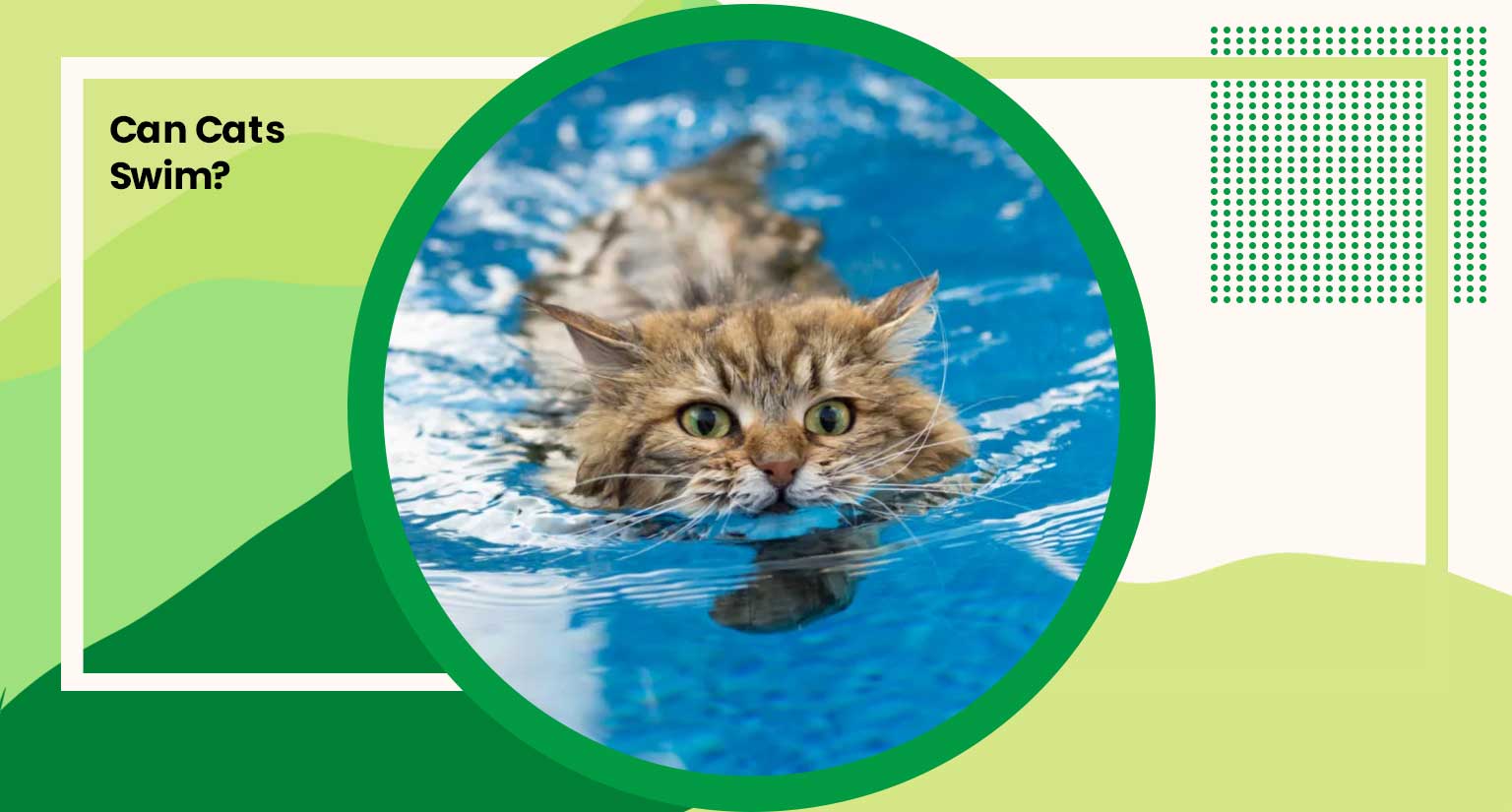Can Cats Swim?
Having an interest often causes us to ask interesting questions, and one of the most common among cat owners and lovers is, Can cats swim?
In this exploration, we are going to go deep into the world of cat behavior and physiology to discover the truth about cats and their relationship with water.
Whether you’re a concerned pet parent or simply intrigued by the idea of a feline paddle, we’ve got the answers you seek. Let’s embark on this journey together and unveil the secrets behind cats and their aquatic capabilities.
How is a cat trained to swim?
Teaching a cat to swim can be quite challenging as most cats are naturally averse to water.
However, with patience, positive reinforcement, and a gradual approach, it is possible to introduce some cats to water and help them become comfortable swimming.
Here’s a step-by-step guide detailed breakdown of the steps you can take to introduce your cat to swimming:
Prepare the Environment
Choose a small, shallow body of water such as a bathtub, a kiddie pool, or a shallow area of a calm lake.
Ensure the water level is just enough to cover the cat’s legs.
Check the water temperature; it should be lukewarm, neither too hot nor too cold. Have towels and treats nearby for positive reinforcement.
Gradual Introduction
Start by letting your cat explore the area without getting into the water.
Allow them to investigate and get accustomed to the sights and sounds of the water.
Use toys or treats to encourage your cat to approach the water voluntarily. Place treats near the water’s edge to create positive associations.
Getting Used to Moisture
Gently dampen your cat’s paws or fur using a damp cloth or your fingers.
This helps them get used to the sensation of being wet.
Offer treats or praise while they’re getting damp to reinforce positive feelings about being wet.
Use Positive Reinforcement
Introduce a floating toy or a buoyant object in the water to pique your cat’s interest.
Cats are curious and might be enticed to investigate, gradually getting into the water.
Offer treats or use their favorite toys to encourage exploration and interaction with the water.
Support and Encouragement
When your cat starts to get into the water, support them gently under their belly.
This provides a sense of security and helps them feel more comfortable.
Stay close and provide encouragement in the form of gentle words and strokes. Reassure them if they seem anxious.
Movement and Paddling
Guide your cat’s legs in a paddling motion gently. Use your hands to simulate a swimming motion.
Be patient and give them time to adjust. Praise any positive attempts at movement.
Short Sessions and Gradual Progress
Keep initial swimming sessions short, around 5-10 minutes, to prevent stress or anxiety.
Gradually increase the time as your cat becomes more comfortable.
Monitor your cat’s behavior closely. If they seem distressed or unhappy, stop the session immediately and try again later.
Post-Swim Care
After the swim, gently towel-dry your cat to remove excess moisture.
Use treats or extra affection to reassure them and create a positive association with the experience.
Consistency and Respect
Understand that not all cats will take to swimming, and some may never feel comfortable with it.
Respect your cat’s preferences and comfort levels. Be consistent in your approach, offering positive reinforcement and patience in each session.
Know When to Stop
If your cat consistently shows signs of distress, fear, or discomfort, it’s crucial to stop attempting to teach them to swim.
Not all cats are inclined or able to enjoy swimming, and forcing the issue can be detrimental to their well-being.
Every cat is unique, and while some might take to water more readily, others may never feel comfortable swimming. Always prioritize your cat’s well-being and comfort throughout the process.
If your cat consistently resists or shows distress, it might be best to find other ways to keep them active and entertained that align more with their preferences.
Are Cats Naturally Drawn to Water?
Cats and water – it’s a combination that often sparks curiosity and, at times, concern.
To answer the question, Are cats naturally drawn to water? we must delve into the fascinating realm of feline behavior.
Not Quite Natural Water Lovers
Cats are not known to be natural water enthusiasts. In general, domestic cats tend to avoid water, and you’ve probably witnessed your feline friend diligently grooming itself to stay clean.
The reasons behind this aversion to water lie in their evolutionary history. Cats’ ancestors were desert-dwelling creatures, and their bodies are well-equipped for arid environments.
They have dense fur that doesn’t dry quickly, making them less buoyant and comfortable in water.
Differences
Most cats may instinctively avoid water, there are exceptions to this rule.
Some cats might display a fascination or even an affinity for water.
This can be influenced by their individual personalities and early experiences with water.
You might come across a cat that enjoys playing with water or doesn’t mind getting a little wet.
Safety Precautions
It’s essential to remember that even if some cats tolerate water, it doesn’t mean they are proficient swimmers.
Their instinctual response may still be to avoid deep water, and they can easily become stressed in aquatic situations.
Cats are not “natural” swimmers, their reactions to water can vary widely.
We will explore some of the scenarios where you might encounter cats and water, shedding light on how to ensure their well-being in aquatic situations.
Can Cats Swim in Pools?
When it comes to cats and water, swimming in a pool is a scenario that can raise a multitude of questions for pet owners.
Let’s explore whether cats can swim in pools and what precautions you should take if they find themselves in this aquatic environment.
Cats’ Swimming Abilities
Cats are not natural swimmers, and they often have an instinctive aversion to water.
However, in certain situations, a cat might find itself in a pool.
In these cases, cats can indeed swim, but it’s not a skill they typically master with grace and confidence.
They will paddle to stay afloat, but their primary instinct will be to reach dry land as quickly as possible.
Precautions for Pool Safety
If you have a pool and are a cat owner, it’s crucial to take precautions to ensure your feline friend’s safety:
Supervision
Never leave your cat unattended near the pool, especially if they haven’t had prior positive experiences with water.
Provide Easy Exit
Make sure your pool has easy escape routes, such as ramps or steps, to help your cat climb out if they accidentally fall in.
Keep the Pool Covered
When not in use, consider covering your pool to prevent accidental falls.
Freshwater Access
Ensure your cat has access to freshwater sources and shade by the pool to keep them hydrated and comfortable.
Cats can swim, it’s essential to understand that they may not enjoy being in the water, and their primary instinct will be to escape the pool as soon as possible.
Can Cats Swim?
The burning question on many pet owners’ minds is whether cats can actually swim.
I’ve often pondered this myself, and the answer isn’t as straightforward as you might think.
Natural Instincts
As a cat lover, you may have noticed that most cats tend to avoid water whenever possible.
It’s not that they can’t swim, but rather that it’s not a skill that comes naturally to them.
This aversion to water is deeply ingrained in their instincts, stemming from their ancestors who were skilled desert dwellers.
Exception to the Rule
Most cats may give water a wide berth, there are those exceptions, the outliers, who seem to defy the stereotype.
Some cats don’t mind getting their paws wet and might even show an interest in water.
It’s a bit like a personality quirk; they’re just a little more adventurous when it comes to H2O.
Safety First
Now, even if your feline friend falls into the “water-loving” category, it’s crucial to remember that cats are not born swimmers.
They can paddle and stay afloat for a short while, but their primary instinct is to find dry land as soon as possible.
So, while they may not exactly sink like a stone, they’re not going to compete in the Olympic swimming events either.
Do All Cats Hate Water?
The age-old belief that cats universally loathe water has led to many a humorous anecdote and viral video.
However, is it accurate to claim that all cats share an aversion to water?
Let’s unravel the truth behind this common belief and see if there’s more to it than meets the eye.
General Disinclination
It’s true that the majority of cats tend to show a dislike for water.
This can be traced back to their evolutionary history as desert-dwelling creatures.
Their dense fur, designed for arid environments, doesn’t lend itself well to waterlogged situations.
As a result, most cats will instinctively avoid water whenever they can.
Exceptions to the Rule
But here’s the intriguing part – there are exceptions. Some cats defy the stereotype.
These unique individuals may not only tolerate water but even exhibit a curiosity or fascination with it.
It’s as if they didn’t get the memo about cats hating water.
Personality and Early Experiences
A cat’s relationship with water can often be linked to its personality and early life experiences.
Cats with more adventurous and outgoing personalities might be more open to water-based interactions, while those with shyer or reserved personalities might avoid water at all costs.
Understanding Your Cat
The key takeaway here is that while many cats have an aversion to water, it’s not an absolute rule.
It’s essential to understand your specific cat’s preferences and boundaries when it comes to water.
Various scenarios where cats may encounter water and how you can navigate these situations based on your individual feline friend’s preferences.
Is It Safe to Swim a Cat?
Swimming a cat can be a tempting idea, whether out of curiosity or perhaps a desire to share a unique experience with your feline companion.
But is it genuinely safe to take the plunge with your cat?
Let’s dive into the intricacies and explore some unique reasons why this practice should be approached with caution.
Stress and Anxiety
Cats are creatures of habit and often thrive on routine and predictability.
Introducing them to a new and potentially anxiety-inducing experience like swimming can lead to stress.
The unfamiliar sensation of being in water can unsettle your cat, and prolonged exposure may exacerbate this stress.
Territorial Instincts
Cats are territorial animals, and the introduction of water can disrupt their sense of security.
It may feel like an invasion of their personal space, leading to discomfort and even defensive behavior.
Physical Discomfort
Cats have a natural aversion to water due to their dense fur and the fact that it doesn’t dry quickly.
When a cat gets wet, it can lead to discomfort and chilling. Prolonged exposure to water can potentially lead to health issues, such as hypothermia.
Scratching and Biting
Cats can be unpredictable when faced with a situation they dislike.
They may scratch or bite in an attempt to escape, potentially causing injury to themselves or their human companions.
Negative Association
Swimming experiences that result in stress, discomfort, or fear can create a negative association with water.
This could lead to long-term anxiety issues or aversions to other water-related activities, such as bathing.
Safety Hazards
If a cat is not comfortable in water and is unable to swim effectively, there’s a risk of drowning.
Cats are not natural swimmers, and their swimming abilities are limited compared to other animals.
There may be rare cases of cats that tolerate or even enjoy water, it’s generally best to respect their natural instincts and avoid subjecting them to swimming experiences.
Always prioritize your cat’s well-being and emotional comfort when considering any unique activities involving water.
Conclusion
Cats and their relationship with water, we’ve learned that while most cats may not naturally gravitate toward water, there are exceptions. It’s crucial to understand your cat’s unique preferences and boundaries when it comes to water.
Swimming a cat should be approached with caution, as it can lead to stress, anxiety, and potential physical discomfort.
Prioritizing your feline friend’s well-being and comfort is essential when considering any water-related activities.


